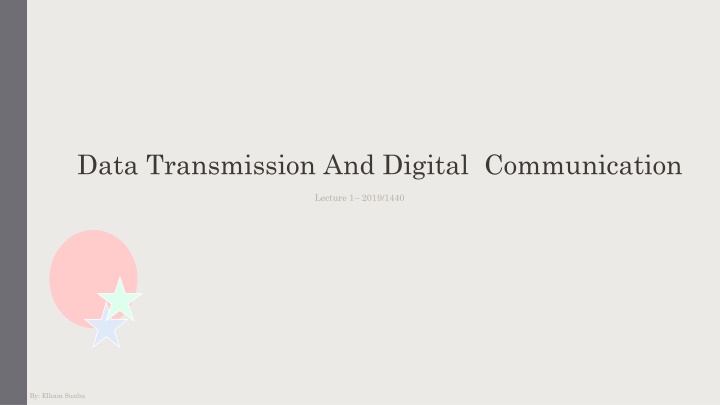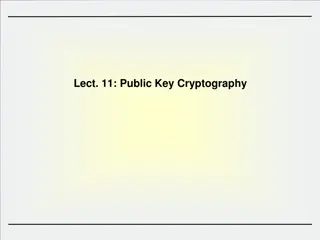
Digital Communication Lecture: OSI Model and Layered Tasks Overview
Explore the fundamentals of data transmission and digital communication, including an introduction to MATLAB, the OSI model, and layered tasks in our daily lives. Understand the functions of each layer in the OSI model and the 7-layer model's utilities utilized by application programs. Discover the interaction between layers and tasks involved in sending a letter, providing a comprehensive overview of key concepts.
Download Presentation

Please find below an Image/Link to download the presentation.
The content on the website is provided AS IS for your information and personal use only. It may not be sold, licensed, or shared on other websites without obtaining consent from the author. If you encounter any issues during the download, it is possible that the publisher has removed the file from their server.
You are allowed to download the files provided on this website for personal or commercial use, subject to the condition that they are used lawfully. All files are the property of their respective owners.
The content on the website is provided AS IS for your information and personal use only. It may not be sold, licensed, or shared on other websites without obtaining consent from the author.
E N D
Presentation Transcript
Data Transmission And Digital Communication Lecture 1 2019/1440 By: Elham Sunbu
OUTLINE Matlab introduction Why Matlab Matlab Software install and interface
Layered Tasks We use the concept of layers in our daily life. As an example, let us consider two friends who communicate through postal mail. The process of sending a letter to a friend would be complex if there were no services available from the post office.
THE OSI MODEL Established in 1947, the International Standards Organization (ISO) is a multinational body dedicated to worldwide agreement on international standards. An ISO standard that covers all aspects of network communications is the Open Systems Interconnection (OSI) model. It was first introduced in the late 1970s. Note: ISO is theorganization. OSI is themodel.
LAYERS IN THE OSI MODEL In this section, we briefly describe the functions of each layer in the OSI model. 1. Physical Layer 2. Data Link Layer 3. Network Layer 4. Transport Layer 5. Session Layer 6. Presentation Layer 7. Application Layer
7-LAYER MODEL OF OSI Physical Datalink Network Transport Session PresentationApplication Application Layer set of utilities used by application programs Presentation Layer formats data for presentation to the user provides data interfaces, data compression and translation between different dataformats Session Layer initiates, maintains and terminates each logical session between sender and receiver
7-LAYER MODEL OF OSI Physical Datalink Network Transport Session PresentationApplication Transport Layer deals with end-to-end issues such as segmenting the message for network transport, and maintaining the logical connections between sender andreceiver Network Layer responsible for making routing decisions Data Link Layer deals with message delineation, error control and network medium access control Physical Layer defines how individual bits are formatted to be transmitted through the network
INTERNETS 5-LAYER MODEL Physical Datalink Network TransportApplication Application Layer used by application program Transport Layer responsible for establishing end-to-end connections, translates domain names into numeric addresses and segments messages Network Layer - same as in OSI model Data Link Layer - same as in OSI model Physical Layer - same as in OSI model 1- 12
MESSAGE TRANSMISSION USING LAYERS sender receiver Applications Applications A receivinglayer wraps incoming message with an envelope Adds layer related addressing information A receivinglayer removes the layer related envelope and forwards the message up 1- 14
DATA VERSUS SIGNAL Data Signals Electric or electromagnetic encoding of data. Convey meaning within a computer(stored in files). Need to be converted into a signal before transfer . Networks and communication systems transmit signals. can be analog ( information can be audio or video) or digital (binary) Issues related to the transmission of signals: Impairments (also transmission flaws) Capacity of the media
A COMMUNICATIONS MODEL Source generates data to be transmitted Transmitter Converts data into transmittable signals Transmission System Carries data Receiver Converts received signal into data Destination Takes incoming data
COMMUNICATIONS TASKS Transmission system utilization Addressing Interfacing Routing Signal generation Recovery Synchronization Message formatting Exchange management Security Error detection and correction Network management Flow control
Analog vs. Digital x(t) Analog signals Value varies continuously t Digital signals Value limited to a finite set x(t) t Binary signals Has at most 2values Used to represent bit values Bit time T needed to send 1bit Data rate R=1/T bits persecond x(t) 1 1 1 0 0 0 0 T t
Frequency, Spectrum and Bandwidth Time domain (examining the signal over time): Continuous signal - signal with no breaks or discontinuities Discrete signal - signal with a finite number of values Amplitude - the instantaneous value of a signal (Volt) Frequency - inverse of the period in cycles per second, Hertz Phase - measure of relative position in time within a single period (degree or radian)
Frequency, Spectrum and Bandwidth Digitalsignal Audio signal Frequency Domain (signal viewed as a function of frequency): any signal is made up of components at various frequencies, each sinusoid Spectrum- the range of frequencies in a signal Absolute bandwidth - is the width of the spectrum (fn - f1) where, fn is largest frequency in signal and f1 is the smallest
Modulation and Encoding schemes Modulation: Encoding:
Conversion Encoding Modulation Digital data to digital signal : less complex and less expensive equipment than analog modulation equipment. Digital data to analog signal : Some transmission media can propagate analog signals only. Example: fiber , wire. Analog data to digital signal : To use the modern digital transmission and switching equipment. 1. Transmit baseband signal over wire transmission (Microwave) => Low frequency baseband means few kilometer antenna !!! 2. shift baseband signals of several voice channel (FDM).
GUIDED MEDIA Guided media, which are those that provide a conduit from one device to another, include twisted-pair cable, coaxial cable, and fiber-optic cable. Topics discussed in this section: Twisted-Pair Cable Coaxial Cable Fiber-Optic Cable
UNGUIDED MEDIA: WIRELESS Unguided media transport electromagnetic waves without using a physical conductor. This type of communication is often referred to as wireless communication.
Thank You 40



